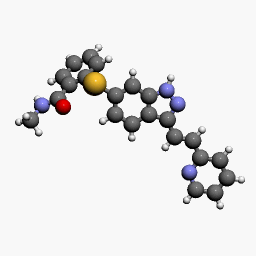RCC Drug Axitinib Could Treat TKI-Resistant CML
Researchers have shown that axitinib could be repurposed as a treatment for CML patients resistant to standard TKIs through a certain molecular mechanism.
Ball-and-stick model of axitinib

In a paper that shows the benefits of looking at old drugs in new ways, researchers showed that axitinib could be repurposed as a potentially effective treatment for chronic myeloid leukemia (CML) patients who develop resistance to standard tyrosine kinase inhibitors (TKIs) through a certain molecular mechanism.
The BCR-ABL1 kinase domain gatekeeper mutation known as T315I confers resistance to all approved TKIs except for ponatinib. That drug, unfortunately, led to frequent severe adverse vascular events, resulting in trial terminations and temporary withdrawal from the market. “Therefore, there is a significant, unmet need for safe and effective therapies for BCR-ABL1(T315I)-driven leukemia,” wrote researchers led by Tea Pemovska, MSc, of the University of Helsinki in Finland.
Pemovska and colleagues combined “drug sensitivity and resistance profiling” of ex vivo patient cells to determine that axitinib, a VEGFR TKI currently approved for the treatment of renal cell carcinoma (RCC), could inhibit T315I-mutated BCR-ABL1-driven leukemia. They published a research letter online ahead of print in Nature.
At both biochemical and cellular levels, the authors wrote, axitinib potently inhibited the target. It did this by binding to the active form of ABL1(T315I) in a mutation-selective binding mode. Ex vivo testing using other TKIs showed that dasatinib, imatinib, and nilotinib could not achieve the same efficacy as axitinib or ponatinib.
The researchers then tested axitinib in the T315I CML patient from whom the CML cells had originated. The patient was treated with the approved therapeutic dose of axitinib (5 mg twice daily) for 2 weeks. This treatment “resulted in a rapid clearance of BCR-ABL1(T315I)-positive cells” from bone marrow, suggesting that this drug could produce effective responses in this particular form of the disease.
“This narrow-profile gatekeeper-selective mechanism of action highlights axitinib as a new type of ABL1 kinase inhibitor,” the authors wrote. “Since axitinib is already approved for patients with refractory renal cell carcinoma and has manageable side effects, our study provides a solid rationale for formal exploration of the clinical utility of axitinib in drug-resistant BCR-ABL1(T315I)-driven leukemia in a fast-track mode, probably in combination with a conventional ABL1 inhibitor.”
Axitinib, which functions as an angiogenesis inhibitor, is also in clinical trials for other malignancies, including glioblastoma, prostate cancer, melanoma, and hepatocellular carcinoma. The researchers also concluded that this work “highlights the value of drug repositioning, that is, searching for novel indications for existing, emerging, and abandoned drugs, such as in the National Institutes of Health program Discovering New Therapeutic Uses for Existing Molecules.”
Targeted Therapy First Strategy Reduces Need for Chemotherapy in Newly Diagnosed LBCL
December 7th 2025Lenalidomide, tafasitamab, rituximab, and acalabrutinib alone may allow 57% of patients with newly diagnosed LBCL to receive less than the standard number of chemotherapy cycles without compromising curative potential.